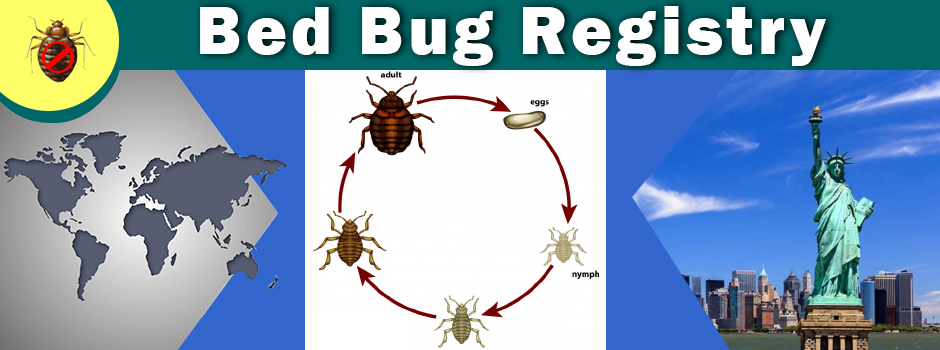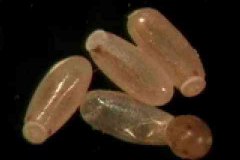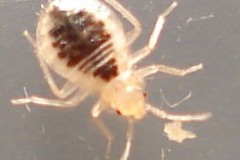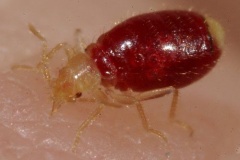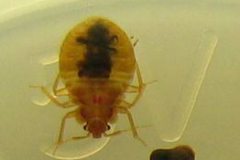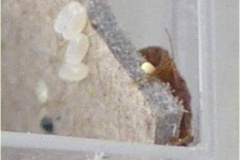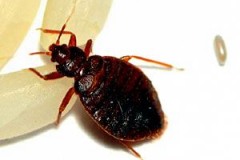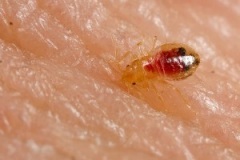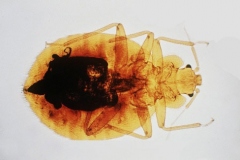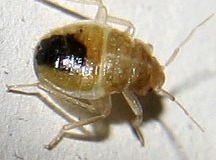More resources
All members of the bed bug family feed on the blood of birds or mammals. The bed bug, Cimex lectularius, attacks man, as does the Eastern bat bed bug, Cimex adjunctus. Bed bugs are active only at night, usually just before dawn. During the day, they hide in cracks and crevices in walls, floors, beds, and furniture. When only a few bed bugs are present, they live close to human sleeping areas; when numerous, they can be found in many rooms of the house. A characteristic bed bug odor is frequently present in a home infested with bed bugs.
Image 1. Adult bed bug
Bed bugs are oval, chestnut-brown insects and are flattened from top to bottom. Adult bed bugs (Fig. 1) measure about inch in length. The mouthparts are shaped into an elongated proboscis, which, when not in use, is held directed backward underneath the body. When a bug is ready to feed, the proboscis is extended forward and the stylets within are thrust into the skin of a host. Mated female bed bugs deposit their eggs in their resting places. One female will produce about 345 eggs during her lifespan.
The bugs grow by molting several times. Nymphs look very much like the adults, except they are smaller and not sexually mature. There are five nymphal molts, and each nymph must have a blood meal to be able to molt to the next stage. Adults feed once a week on average but feed many times during their four-month or longer lifespan.
It is common for bed bugs to come into a home via secondhand articles and furniture. They may also migrate between homes via wires, plumbing, or rain gutters. In addition, since warehouses, trucks, and railroad cars may be infested, common bed bugs can infest homes by stowing away on new furniture stored or shipped from these places. People frequently carry the bugs home in luggage from infested hotels and vacation rentals.
The Eastern bat bed bug comes into homes in the spring with colonies of bats. They can be found in the living quarters of homes in many of the same places as common bed bugs, but the source of the infestation is located within walls or attic areas.
Image 2. Adult bed bug
Despite the fact that the bed bug can acquire many human disease organisms during feeding, there have been no documented cases of disease transmission as a result of bites. However, their bites can produce irritating, itching, and burning sensations. Bed bugs feed rapidly, becoming engorged in less than ten minutes. The act of biting is usually not felt, but later there is an allergic reaction to the protein found in the bed bugs saliva. A colorless wheal or lump develops at the bite location; in contrast, flea bites have reddish centers. Discomfort from bed bug bites may last a week or more. Occasional bites indicate a beginning light infestation of adults; many bites result from a heavy, long-standing population of nymphs and adults.
NOTE: It is not advisable for homeowners to attempt to treat for bed bugs. Most of the necessary insecticides are only for sale to and use by professional pest-management companies. If homeowners try to control these bugs with over-the-counter products, the bed bugs likely will become dispersed, resulting in a more difficult treatment required at a later date.
Bed bugs become established in structures when they hitch a ride in boxes, baggage, furniture, bedding, laundry, and in and on clothing worn by people coming from infested sites. Poultry workers can carry bed bugs to their residences from their places of work. Bat bugs, poultry bugs, swallow bugs, and others are typically transported to new roosts by the principal host. An accurate identification of the bed bug species involved is essential to an effective control strategy. Many control failures can be traced to an incorrect identification.
Bed bugs hides in cracks, crevices, and seams during the day. They prefer narrow crevices with a rough surface where their legs and backs touch the opposing surfaces. Bed bugs have difficulty climbing polished glass surfaces. Wood and paper surfaces are preferred to either stone, metal, or plaster; however, in the absence of preferred sites or during high population numbers, the latter will also be utilized. The aforementioned cracks and crevices should be filled with appropriate fillers, such as caulking.
Bugs will sometimes hide in the crevices of upholstered furniture and mattresses created by folds, buttons, and cording. Thoroughly vacuum all upholsteryincluding the undersidesmattresses, and pillows. Launder bedding and dry in a warm air dryer. Mattresses, upholstered furniture, and cushions can be treated with dry steam. It is best to use two professional-grade steamers with low vapor flow rates, each with one-gallon capacities. This allows one unit to always be hot between water refills. The steam should exit through a wand with multiple ports to reduce the risk of blowing the bugs out of their hiding places. Using an infrared thermometer, make certain that the area just treated is at least 176F. (80C). Depending on the steam unit used, the wand should pass over the surface of the fabric at about a foot every ten seconds. Two products, Bedlam (phenothrin w/ pyrodone) and Sterifab (phenothrin w/ isopropanol), are registered for application to mattresses, pet bedding, carpets, and other sensitive areas as allowed by the labeling. Bedlam has been shown to have ovicidal properties with up to 90 percent of bed bug eggs not hatching. Both materials have excellent contact kill and demonstrate residual activity for up to seven days.
Pesticides can be applied to cracks and crevices of dressers, wooden bed frames and headboards, door and window trim, baseboards, and similar sites. Three classes of insecticides are reviewed: (1) Botanical insecticides containing natural pyrethrins will repel insects and can knock down bed bugs for a period of time, but natural pyrethrins quickly deteriorate and do not provide the necessary residual action of some other materials. Finishes on furniture and other wood items may be damaged from the petroleum carriers contained in aerosol pyrethrins. (2) Inorganic materials such as silica gel, boric acid, and diatomaceous earth will provide long-term control, provided they are used in an environment with low humidity. These inorganic materials have very low repellency, a long residual life, and can provide good control if thoroughly applied to cracks and crevices. However, they are typically white in color and may leave the surface of items with an undesirable film unless they are carefully applied. (3) Synthetic pyrethroids such as deltamethrin, lambda-cyhalothrin and others can provide good control if they are carefully and thoroughly applied to suspected bed bug harborages. They are relatively long-lived residuals and will not damage materials that are not harmed by water. Consideration should be given to the fact that people typically spend in excess of eight hours per day in the bedroom. If the insecticides are properly applied, there should be little risk of exposure. Recent studies have demonstrated that some populations of bed bugs are exhibiting resistance/tolerance to several of the more commonly used synthetic pyrethroid insecticides. However, the microencapsulated materials such as Onslaught (esfenvalerate) and Demand CS (lamba-cyhalothrin), and a suspended concentrate, Suspend SC (deltamethrin), can offer rapid reduction of susceptible populations. Bed bugs have not shown resistance to a relatively new material, Phantom (chlorfenapyr). However, chlorfenapyr may require ten days kill the bugs. During this ten-day period it is important to realize that the bugs may still be active and females may wander and deposit viable eggs in other locations. These products are injected or sprayed into cracks and crevices or bed frames, baseboards, dressers and drawers, and as spot treatments to carpet along walls. An insect growth regulator, (S)-hydroprene (Gentrol), interferes with the bugs development and renders the adults sterile. Since it does not kill adults or nymphs it must be used in conjunction with a contact insecticide such as Phantom, Suspend, Demand, and so forth. Gentrol is applied to the same locations as these contact insecticides. Heat treatments, in conjunction with insecticides, is a very effective strategy to control bed bugs.
For bed bug infestations other than the common bed bug, C. lectularius, the bird or bat that has occupied the structure should be removed and measures taken to prevent the reentry of the animals. The materials listed for the common bed bug will also control the other species, providing that treatment considerations be given to the potential harborages (e.g., crevices between rafters, cracks in chimney flues) that will differ from the common bed bug.
More resources
Pesticides are poisonous. Please read and follow the directions and safety precautions on the labels. Handle them carefully and store them in their original labeled containers out of the reach of children, pets, and livestock. Dispose of the empty containers right away, in a safe manner and place. Do not contaminate forage, streams, and ponds.
Authored by: Steve Jacobs, Sr. Extension Associate April 2003 Revised February 2015
Go here to see the original:
Bed Bugs - Department of Entomology (Penn State University)

 Residence
Residence  Location
Location 
